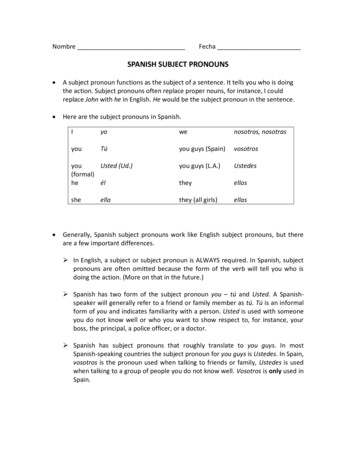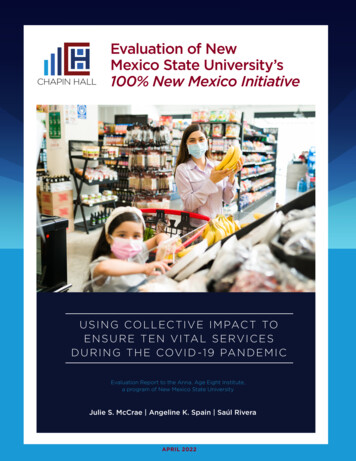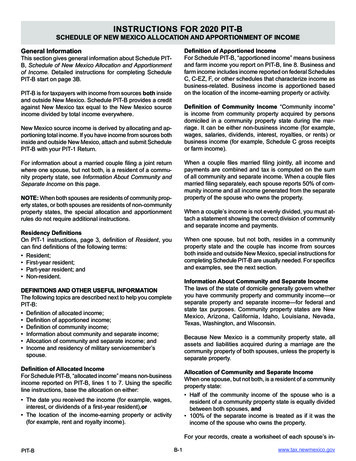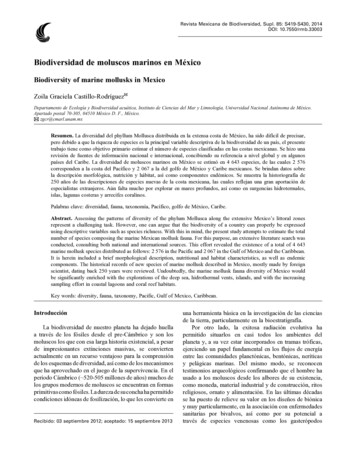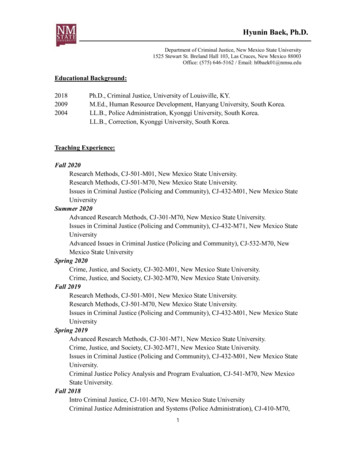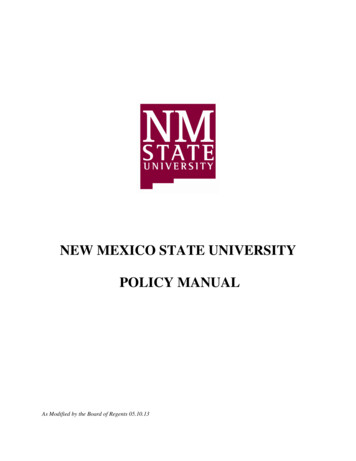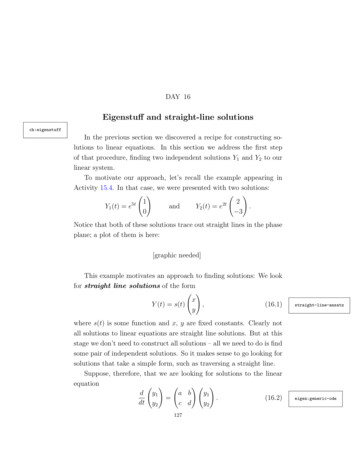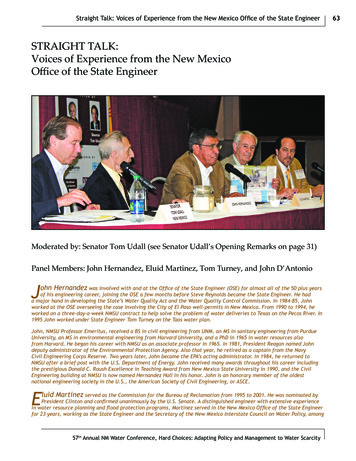
Transcription
Straight Talk: Voices of Experience from the New Mexico Office of the State EngineerSTRAIGHT TALK:Voices of Experience from the New MexicoOffice of the State EngineerModerated by: Senator Tom Udall (see Senator Udall’s Opening Remarks on page 31)Panel Members: John Hernandez, Eluid Martinez, Tom Turney, and John D’AntonioJohn Hernandez was involved with and at the Office of the State Engineer (OSE) for almost all of the 50 plus yearsof his engineering career, joining the OSE a few months before Steve Reynolds became the State Engineer. He hada major hand in developing the State’s Water Quality Act and the Water Quality Control Commission. In 1984-85, Johnworked at the OSE overseeing the case involving the City of El Paso well-permits in New Mexico. From 1990 to 1994, heworked on a three-day-a-week NMSU contract to help solve the problem of water deliveries to Texas on the Pecos River. In1995 John worked under State Engineer Tom Turney on the Taos water plan.John, NMSU Professor Emeritus, received a BS in civil engineering from UNM, an MS in sanitary engineering from PurdueUniversity, an MS in environmental engineering from Harvard University, and a PhD in 1965 in water resources alsofrom Harvard. He began his career with NMSU as an associate professor in 1965. In 1981, President Reagan named Johndeputy administrator of the Environmental Protection Agency. Also that year, he retired as a captain from the NavyCivil Engineering Corps Reserve. Two years later, John became the EPA’s acting administrator. In 1984, he returned toNMSU after a brief post with the U.S. Department of Energy. John received many awards throughout his career includingthe prestigious Donald C. Roush Excellence in Teaching Award from New Mexico State University in 1990, and the CivilEngineering building at NMSU is now named Hernandez Hall in his honor. John is an honorary member of the oldestnational engineering society in the U.S., the American Society of Civil Engineering, or ASCE.Eluid Martinez served as the Commission for the Bureau of Reclamation from 1995 to 2001. He was nominated byPresident Clinton and confirmed unanimously by the U.S. Senate. A distinguished engineer with extensive experiencein water resource planning and flood protection programs, Martinez served in the New Mexico Office of the State Engineerfor 23 years, working as the State Engineer and the Secretary of the New Mexico Interstate Council on Water Policy, among57th Annual NM Water Conference, Hard Choices: Adapting Policy and Management to Water Scarcity63
64STRAIGHT TALKother positions. He was the first Hispanic American to serve as commissioner in Reclamation’s 90 year history, and is anative of Rio Arriba County, New Mexico. Martinez received an undergraduate degree in engineering at New Mexico StateUniversity and is a licensed Professional Engineer and Land Surveyor. He currently is with Water Resources ManagementConsultants LLC in Santa Fe, NM.Tom Turney P.E. was New Mexico State Engineer from April 1995 to February 2003, responsible for themeasurement, apportionment, and distribution of the waters of the State of New Mexico. During his tenure, amongother accomplishments, he oversaw development of administrative guidelines for water management within the stateand developed the process to begin to deny or approve protested water right applications, which had been backloggedfor nearly three decades. Currently, Tom is a consulting engineer on water rights, water administration and policy, andwater supply within New Mexico. He earned bachelor’s and master’s degrees from New Mexico State University in civilengineering and is a registered Professional Engineer in New Mexico.John D’Antonio is a registered professional engineer in New Mexico and Colorado, former New Mexico StateEngineer, and became the Deputy District Engineer for the U.S. Army Corps of Engineers Albuquerque District inNovember 2011. He has experience in hydraulic design, acequia rehabilitation, water resource management, water policydevelopment and project management for both civil works and military construction projects. Before he was appointedby Governor Bill Richardson to the state’s chief water post, John served as the Cabinet Secretary of the New MexicoEnvironment Department. He served as the Director of the Water Resource Allocation Program for the Office of the StateEngineer from 2001 to 2002 and as the District 1 Supervisor in Albuquerque from 1998 to 2001.John previously worked for 15 years with the U.S. Army Corps of Engineers as a hydraulic design engineer and was theproject manager for Cannon Air Force Base and for the Acequia Rehabilitation Program. A native New Mexican, D’Antonioreceived a bachelor’s degree in civil engineering from the University of New Mexico in 1979. He was a member of theGovernor’s Blue Ribbon Task Force on Water Issues from 1998 to 2011. During his nine year tenure as State Engineer, Johnwas Secretary of the Interstate Stream Commission, Chairman of the Water Trust Board; Governor’s Water InfrastructureInvestment Team; and the Governor’s Drought Task Force. He also served as the New Mexico Commissioner to the RioGrande, Costilla, and Upper Colorado River Compacts.[The following conference panel discussion was transcribed and edited for these proceedings. If you would liketo listen to the original webcast, please go to the NM WRRI website at: http://wrri.nmsu.edu, click on the 57thAnnual New Mexico Water Conference – August 28, 2012 and click on “Webcast.”]Senator Udall: This is one of the most exciting panels that I think we aregoing to hear today. While sitting in Washington doing a bit of planning forthis conference, I thought we should have a panel with former engineers andcall it “Straight Talk: Voices of Experience from the New Mexico Office ofthe State Engineer.” I really believe that these guys have the ability to give usthe straight talk on water in New Mexico. Before I start, I want to thank ourcurrent State Engineer, Scott Verhines, for his remarks during lunch. He is adedicated public servant with a tough job.I personally wanted to get this group of former State Engineers together sowe could hear lessons from the past that we can apply to the future. Let memake some brief introductions and then we’ll begin the discussion. First,on my left, is John Hernandez, who spent almost 50 years in and out of theOffice of the State Engineer under several administrations. He is professoremeritus here at New Mexico State University and is a tremendous resourcefor our conference. Next to him is Eluid Martinez, who was State Engineerfrom 1991 to 1994, and who also served as Commissioner of the Bureauof Reclamation from 1995 to 2001 as its first Hispanic Commissioner inits history and is also a graduate of New Mexico State University and aAugust 28, 2012
Straight Talk: Voices of Experience from the New Mexico Office of the State Engineerconsulting professional engineer. Next to him is Tom Turney who servedas State Engineer from 1995 to 2003 and was a leader on water managementissues. He, too, is an NMSU graduate and consulting professional engineeron water issues. And lastly, John D’Antonio is our most recent past StateEngineer serving from 2003 to 2011 and is currently the Deputy DistrictEngineer for the U.S. Army Corps of Engineers in the Albuquerque District.Welcome everyone.To add a little diversity to our panel, John Hernandez received hisengineering degree from UNM, so it’s not exclusively a New Mexico StateUniversity panel. I want to thank all of you for traveling here from Santa Feand Albuquerque to participate. My goal is to stop talking and facilitate agreat discussion. As former Engineers, you are able to come to this conferenceand be truth tellers. As State Attorney General, I became very familiar withthe process of being appointed by the New Mexico Senate, and once you areappointed, you can only be removed for “cause.” Appointees, like the StateEngineer, should be independent and these guys are independent. They aregoing to tell us the truth about water. We’ll let them start by commenting onanything that they have heard today.John Hernandez: I like the title of this panel—straight talk on difficultdecisions. I’m going to talk principally about one concerning the Pecos River,which I’ll talk about in a bit.Eluid Martinez: I want to take a few moments to acknowledge Dr. JohnHernandez. If it weren’t for the fact that Bruce King was elected governor in1994 instead of Frank Bond, John would have been State Engineer insteadof me. He has taught former State Engineers and advised them and I have acertificate here making him an honorary State Engineer for the purposes ofthis discussion. I think the State of New Mexico owes John a lot. Thank you,John.Let me leave you with some starting thoughts. New Mexico water rightsadministration cannot be compared to water rights administration in otherwestern states because New Mexico is unique in its problems and its wateruses. When I was State Engineer, I recall attending a meeting with otherwestern engineers and one of the state engineers, I believe from Montanaor Wyoming, told me he was quite proud of the fact that the earliest waterpriority in his state was from the late 1880s. I looked at him and said, “Is thatearly?” In New Mexico, inhabitants were using water prior to 1000 and bythe 1700s, some of the rivers were fully appropriated. We are dealing witha completely different kind of use—by Indian tribes, Hispanic acequias,and Bureau of Reclamation projects. When Colorado and other states saythey have taken care of their adjudications, they have been adjudicatingReclamation projects, but they have not dealt with many Indian waterissues and surely not some Hispanic acequia issues. New Mexico issues arecompletely different than other western states. Another recollection I havefrom my days as Commission of Reclamation was visiting Hoover Dam. TheDam’s staff took great pride in showing me the generators at Hoover Dam.They showed me the penstock pipes that come into the generators and theywere approximately 15 feet in diameter and flowing full of water. You couldprobably put all of New Mexico’s water flowing in its rivers into one or twoof those pipes. But the other interesting thing was that when I went up toGrand Coulee Dam, they showed me their generators and reminded me ofthe penstocks at Hoover Dam that were 15 feet in diameter and the spillway57th Annual NM Water Conference, Hard Choices: Adapting Policy and Management to Water Scarcity65
66STRAIGHT TALKtunnels that you could drive a semi-truck through—and those tunnels werethe size of the penstocks into their generators. When you talk about theColumbia River, all the water in New Mexico I administered over ten yearscould probably flow through one of those penstocks in a few seconds. I’mnot saying they don’t have their water issues on the Columbia River or onthe Colorado River. But what we have in New Mexico is unique in terms ofhow it administers water. When somebody says that experience in Australiashould teach us something about New Mexico, it might, but it might not.Tom Turney: Thank you, Senator, for organizing this conference on waterscarcity, which is a very important subject. We saw a graph earlier thismorning that included the last couple thousand years of precipitation. Figure1 is basically the same graphic the Senator showed earlier this morning; thisone was developed by the Office of the State Engineer. It shows averageprecipitation over the last 2100 years. The graph was prepared from researchon trees near the Bandara ice cage near Grants. The startling thing to meabout this graph, and I studied it for years, is that if you look to the yearsprior to the 1950s, it shows that there were a whole lot worse conditions thathave occurred in the past. History tells us that drought is going to happenagain and what we are experiencing now will probably continue and it mayget worse before it gets better. This kind of conference is totally appropriateas there are hard decisions that are going to have to be made in the future.This graph speaks to the necessity for establishing policies, whether theyconcern conjunctive management, priority of use, or issues of that nature.Figure 1. Rainfall in NW New Mexico, 136 BC-AD 1992August 28, 2012
Straight Talk: Voices of Experience from the New Mexico Office of the State EngineerJohn D’Antonio: Good afternoon everybody. It’s great being here back atthe annual water conference. What’s so great about New Mexico and aboutwater is that although it can be polarizing the times, it’s also rewarding whenwe can sit here in a group like this to discuss the issues. I see many people inthe audience with whom I’ve dealt: water managers, mayors, city councilors,technical people, former staff and colleagues at the Corps, from in and outof state. The water community is here sitting in this room and no matter thedifferences that we’ve had over the years, the contentiousness that we’ve had,I still can consider it somewhat of a family. I want to thank Senator Udallfor laying some of the groundwork on what I inherited when I became StateEngineer. It is really about people—we have two million people in the Stateof New Mexico and we have very diverse water uses. We are the poster childof water use within the United States. Beside the acequias and the historicalwater use by 22 Native American tribal entities, we have rural folks all overthe state, growing municipalities, environmental groups, and on and on andon. We have various power and energy folks coming to New Mexico now. Wehave every single water user, interest groups, and stakeholder groups thatany other state has and more. What I would like to impart at this point is thatit is a tough job being State Engineer. I think we all know what current StateEngineer Scott Verhines is going to be going through in the next few years.It also is about people and working together for collaborative solutions. Wecan’t get anywhere unless we collaborate.Senator Udall: One of the big issues that I hear about from people like you inthe audience and when I do Townhall Meetings around New Mexico, is thatpeople are concerned about the pressures on the Rio Grande. I know we havea number of other rivers in the state, but let’s stick with the Rio Grande asan example. Some people say we are inevitably going to keep growing NewMexico; we are two million now, we are going to be four million soon, andwe will continue to grow beyond that. So the pressures on the Rio Grandeare going to be enormous as well as on our other rivers. It was pointed outto me that given the current drought, if we didn’t have water stored in thereservoirs in northern New Mexico, and if we didn’t have the water from theSan Juan-Chama Project, the Rio Grande would be dry right now. That is apretty shocking situation, but that is where we would be. How do we addressthis? Do we ask ourselves whether we are going to have unfettered growth?Where are we going to get the water from? Are we going to go out and raidagriculture? We’ve heard many of our speakers talk about acequias andagriculture and how they are a vital part of New Mexico. So where are wegoing to get that water and how are we going to get it? John D’Antonio sayswe need to cooperate and work with each other. But what are the changesthat need to be made?John Hernandez: Years ago, I sat in on an Intel Corp. hearing on water thatrequired the State Engineer Eluid Martinez to make a tough decision. Thequestion concerned whether Intel’s water use was in the public interest.Eluid Martinez: I have the distinction of being tagged as one of NewMexico’s last water buffalo State Engineers. The old State Engineers whowere called water buffaloes were principally engineers whose main activitywas developing water infrastructure. There has been some controversy sincethen that Reclamation and state water officials/buffaloes dammed every riverin the West and dammed the environment. It is interesting how things turn360 and now we are wondering if it were not for those reservoirs, wherewould we be? At any rate, earlier State Engineers—and New Mexico was57th Annual NM Water Conference, Hard Choices: Adapting Policy and Management to Water Scarcity67
68STRAIGHT TALKfortunate to have had one State Engineer for 35 years, Steve Reynolds—wereprincipally involved in making sure that New Mexico was able to exercise allthe waters that have been apportioned to New Mexico through its compacts.Conservation of water meant using every drop that you could put tobeneficial use. Then things started to change: the public perception of the useof water for environmental purposes and the concern about growth and howwater supplies would meet new demand. I recall the first meeting of thisgroup that I attended as a student at New Mexico State University over 40years ago. And the last time I addressed this group was as Commissioner forthe Bureau of Reclamation. The issues discussed 40 years ago or 13 years agoare the same issues sitting before us today. How do we meet increasing waterdemand with limited resources? I subscribe to the old buffalo theory that youhave water, but you do not have enough water to meet all existing demandsand all future demands. Former State Engineer Steve Reynolds used to saythat if you had a reduction of 10 to 15 percent of agricultural demand, youwould double the amount of water available for nonagricultural or municipaluses. The problem is that in New Mexico, as well as throughout the UnitedStates, we are attempting to meet existing demand as well as additionaldemand. I think that is where the hard decisions are to be made: in times ofshortages, where does the water flow? Some states have priority of wateruse. In other words, in times of water shortages, by statute, municipal anddomestic uses take first precedence. New Mexico does not have this under itswater law. All beneficial uses share equally. The point I try to make is that weare in a water-short era and will continue to be in water-short situations aslong as we try to meet existing demand as well as future demand. You cannotaccomplish both objectives.Tom Turney: What Eluid says is very true. There is not enough water to meetall existing demands and all future demands. In the future, there will haveto be administrative changes. The decisions the State Engineer makes areunpopular a lot of times. Everyone who sits up here knows that—you makea decision and 50 percent of the people like it and 50 percent of the peoplehate it. Some get on the phone and even threaten you physically because youdecided a certain way. The State Engineer has some really tough decisionsahead. Concerning the concept of priority of water use in New Mexico, I havenoticed that people will argue in court that every use of water—whetherindustrial, municipal, agricultural, Indian use—everybody wants to havethe number one priority and the maximum amount of water they can get.That is just the way the system works. I think it is a terrible mistake to tryto change today’s priority system or to change the priority of some specialuser/special interest group. I do not think that will be any better than whatwe have now. There will be controversies over the priority system no matterwhat you have. When the New Mexico Constitution was formed—and JohnHernandez’s grandfather actually sat in on this meeting—it created thepriority in time clause and I think it ought to be given a chance to work andwe are lucky that we have it. The State Engineer is going to face some veryhard decisions ahead on the usage of water. It is easy to say that if we take alot of water from agriculture, we can double the population of the state. I donot think it is that easy. I personally think it would be a terrible mistake if wedo away with the state’s historical heritage of agricultural use of water andsteps need to be taken to protect New Mexico’s roots.John D’Antonio: The big question is: Where is the visionary leadership?Where is the next San Juan-Chama Project? If it weren’t for the visionaryAugust 28, 2012
Straight Talk: Voices of Experience from the New Mexico Office of the State Engineerleadership 40 and 50 years ago, we would not have that transmountain watercoming into Albuquerque and Santa Fe today, or the drinking water project,or the Buckman direct diversion. Those projects had their beginnings decadesago and the really good thing about those projects is that they are from arenewable source of supply. That has taken pressure off our groundwater. Iheard this morning discussion about the Ute Pipeline Project and how thatmay not be a good idea. That project has been fully vetted; it provides arenewable source of supply. The investment was made in the 1960s to buildUte Reservoir. That reservoir can bring a pipeline of water down to NewMexico’s eastern communities. Similarly with the Gila project. The Gila iscoined as the last free-flowing river within the state of New Mexico, althoughit is not really. The point being that we certainly need more water in theState of New Mexico. A comment was made that we don’t need that waterin New Mexico; we can let it flow down to Arizona. That is not the visionaryleadership we need for New Mexico. We need more water. I want to pointout the leadership at the Interstate Stream Commission and the leadership ofCommissioner Jim Dunlap who has been very courageous over the last fewyears. A lot of work has been done under his leadership and Director EstevanLopez. They have been talking about new supplies of water. How do we getnew water infrastructure built within the state? How do we augment suppliesto the state? We need to look for the next San Juan-Chama Project for theState of New Mexico. It is about having that visionary leadership. We cannotdo it alone; we’ll partner with local entities, other states, and certainly ourfederal counterparts and that is where the Bureau of Reclamation comes in.Reclamation is a great partner as is the Corps of Engineers.Senator Udall: There seems to be some sympathy on the panel for theidea that you do not necessarily deal with population growth by raidingagriculture or acequias. But what can folks do to protect our agriculture? Asformer State Engineers and advisors to the State Engineer, what would youtell them they should be doing in order to try to protect rural areas, acequias,and agriculture? Is this something that is decided within the Office of theState Engineer or is there something that can be done outside?John D’Antonio: Certainly the State Engineer is the arbiter of all applicationsthat come forward. There is no new water in the State of New Mexico. Youmust file an application if you are going to request a change in place orpurpose of use. We are fully appropriated in just about every basin. There area few areas where we can consider new appropriations but very few. Fourmillion acre-feet of water is diverted every year in New Mexico. In roundnumbers, three million acre-feet or 75 to 78 percent is used by agriculture.We could look at taking out a bit from agricultural to fund that growth,but where is that water and how do we do it? Growth in New Mexico isoccurring in the Rio Grande corridor. Half the state’s population, abouttwo million people, lives from Cochiti down to Las Cruces. There is highdemand there and not enough farmland within the Middle Rio GrandeConservancy District and elsewhere to execute change in place and purposeof use permits to allow for consumptive use of water for the growing citiesand municipalities. So where do we get the water? It is through conservation,reuse, or new supplies, which could be brackish water, deep groundwatersources, desalination, or actually going into old water transfers. That has beentested a couple of times. During my tenure, an application for a Fort Sumnerpipeline was denied because it was too speculative. Another was filed fromthe San Augustine Plains. You are going to see those types of applications57th Annual NM Water Conference, Hard Choices: Adapting Policy and Management to Water Scarcity69
70STRAIGHT TALKcontinue. The economic engine for the State of New Mexico is the MiddleRio Grande and that is where the jobs are going to be. That is where weneed additional water resources. Hopefully at some point, we will havethat balance. We must have agriculture, we must maintain an agriculturalcommunity that allows us in drought years to make short-term transfers outto augment other supplies. But the water needs to stay in agriculture to acertain extent although a small part could be transferred out for permanentuse.Tom Turney: I’m glad John brought up water conservation. It is importantand will continue to be very important for cities, municipalities, and waterassociations to practice conserving water to decrease their demand. TheMiddle Rio Grande Conservancy District has dramatically increased theirefficiency. I think they have cut their diversions close to 50 percent in the lastfew years. This transfer of water from ag to municipal and industrial (M&I)will continue. The State Engineer could create a mechanism for moving waterfrom agriculture to M&I purposes on a short-term basis. The transfers couldbe done for just a few months, which is not the way transfers happen now.Currently you come in and take the water rights from the agricultural landand dry up that land. Some new transfer mechanism could be created thatis different from what has been done historically. Another example of thedemand on agricultural uses is a situation occurring right here between thecity of Las Cruces and the Jornada. There is a small separate undergroundwater basin that is not connected to the Rio Grande. It exists as an isolatedlittle basin. There are proposals to develop a community of several hundredthousand people on this underground water supply that we know won’tlast forever. Purely from a planning perspective, it is a terrible mistake aseventually those communities will run out of water. Meanwhile, they’ll lookover here and see all the water that is being used for agricultural purposes.It is going to be very hard to tell 100,000 or 200,000 people, “Sorry, you aregoing to have to leave.” But they will get their way. I think the legislaturewill be persuaded to encourage a water transfer. But for now, you cannothave a policy that will dramatically impact agriculture the future.Eluid Martinez: Let me pick up where Tom was headed. The current transferprocess is so cumbersome that if a city begins a request to transfer water formunicipal purposes on a short-term basis, the city could disappear before theSupreme Court enters a decision as to whether your permit will be approvedor not. It needs to be advertised, it is subject to protest, subject to DistrictCourt appeal, and so on. What that does is to force municipalities or waterusers to look and acquire water rights long-term so that they are in a positionto be able to use the water when they need it without having to go through atransfer process that might not get them water. So perhaps legislation couldbe put in place that allows transfers in times of drought from ag to M&Ipurposes short-term and quickly. That way a farmer, instead of farmingin a particular year, would provide his water to others short-term. Thataccomplishes two objectives: municipalities get some short-term water andthe farmer continues to farm while leasing his water short-term.The State Engineer has been viewed in the last 10 to 15 years by some groupsas being the last avenue of hope to prevent growth or to use water as a toolto prevent certain activities. To go back to the Intel application that JohnHernandez mentioned earlier, Intel Corporation wanted to expand theirbusiness and protesters’ biggest objection was not water issues but growthissues. The protesters asked the State Engineer to use his authority overAugust 28, 2012
Straight Talk: Voices of Experience from the New Mexico Office of the State Engineerwater to manage growth. My order in that decision, which was not appealedto the District Court and therefore there is no precedence, took the positionthat the role of the State Engineer should not supplant the role of the localplanning and zoning officials. If the State in New Mexico had gone out andrecruited business to New Mexico and the local county had zoned propertyor had provided bonding authorities, and the local planning commission haddone their zoning, I did not believe that it was the place of the State Engineerthrough a water issue to say that growth was not a good thing. I think thatgoes with what Paula Garcia was saying this morning. There is not enoughcase law or State Engineer decisions on the issue of public welfare, but I willsubscribe to you that there is the beginning there.John D’Antonio: When I became State Engineer, the legislature recognizedthat the adjudication process was slow, drought and water challenges wereimminent, and we could not wait for full adjudications. They directed us toput in an expedited transfer process, promulgate rules and regulations, anddo what was necessary to actively manage our water resources. From 2003to 2011, we diligently went on that path. We established 17 basins within thestate, we put in project management plans for all those basins, and we putmeters in place as best we could. When I left the office, we had in excess of 90percent of meters in place and 100 percent of water masters out in the field.We promulgated a general set of rules and regulations that went througha legal barrage of challenges. We have been trying to do what is necessary.You cannot manage water if you do not measure it. Once you measure it, youhave to put things in place and follow through. From my perspective, I gotthe hand-off from Tom Turney and Eluid Martinez who started this process.I needed to get water management into the next century to do managingand expedited transfers as Eluid mentioned. That is one way I think we wereon the cu
NMSU after a brief post with the U.S. Department of Energy. John received many awards throughout his career including the prestigious Donald C. Roush Excellence in Teaching Award from New Mexico State University in 1990, and the Civil Engineering building at NMSU is now named Hernandez Hall in his honor. John is an honorary member of the oldest

